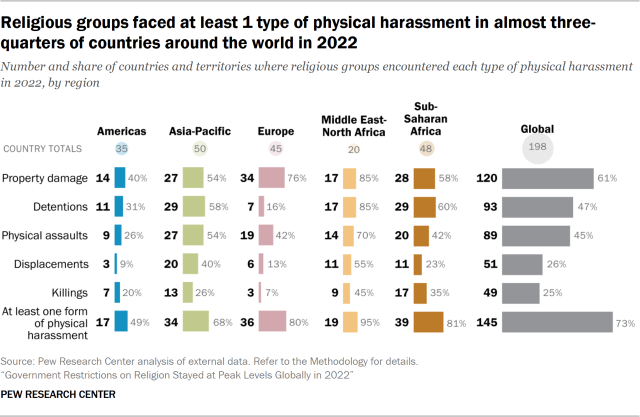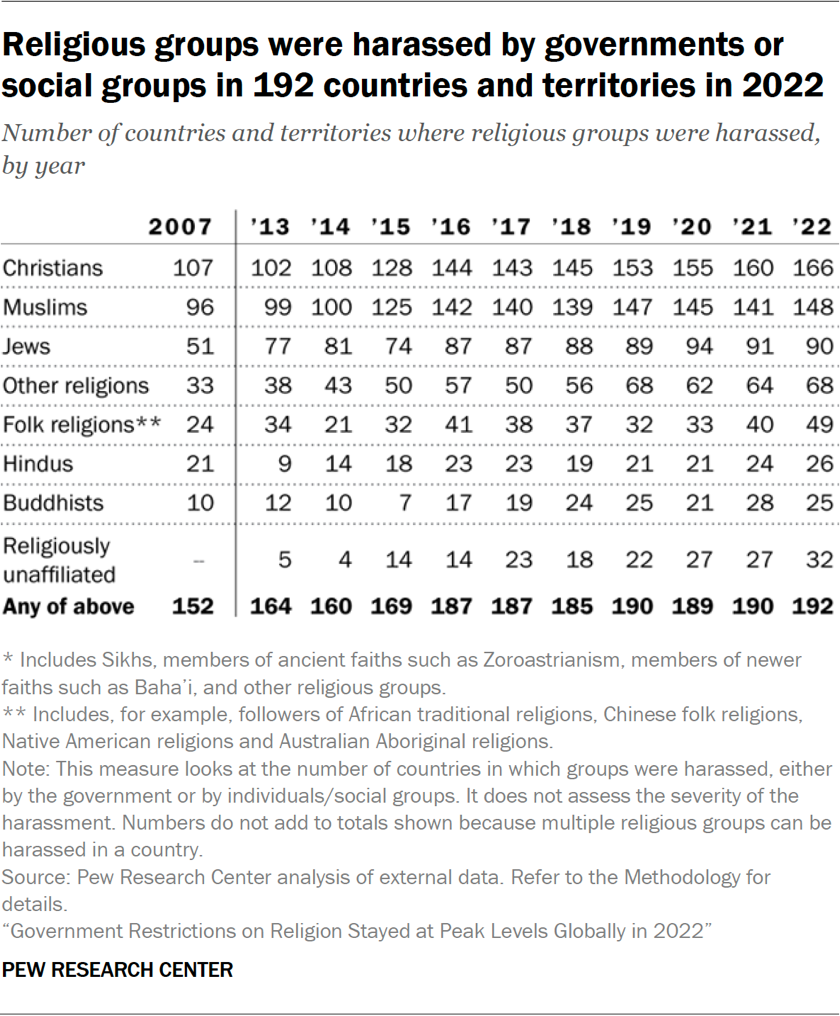By Samirah majumdar
In 2022, harassment of religious groups by governments or social actors occurred in 192 out of the world’s 198 countries and territories, according to sources analyzed in our study. This was an increase by two countries from 2021 and a new peak level for the study.
Here are the key findings:
- Governments harassed people for their religious beliefs and practices in 186 countries in 2022, up from 183 in 2021.
- Social groups or private individuals harassed people due to their religion in 164 countries, the same number as in 2021.
- Governments and/or social actors harassed religious groups in 192 countries, including 158 countries where both governments and social groups or private individuals engaged in harassment.
In this study, harassment includes a range of actions, from disparaging verbal remarks to the physical use of force against religious groups or their property. The findings in this chapter reflect the number of countries where at least one occurrence of any type of religion-related harassment was reported in the sources analyzed. The figures, therefore, show how geographically widespread harassment of religious groups is and whether the number of countries where it occurs is increasing or decreasing. But they do not address which religious groups face the most persecution around the world, because a country is counted whether it had a single instance of harassment against a religious group or numerous ones.
To place a lens on the most serious cases, this chapter examines physical harassment faced by religious groups. It also looks at the number of countries where specific religious groups faced harassment more broadly (either physical or verbal). By physical harassment we mean cases in which physical force was used against religious groups and their property, including damage to property, detentions or arrests, assaults on people, displacements, and killings. By verbal harassment, we mean insults and disparaging public remarks and statements or articles about religious groups in the media.

The figures also include countries where there was harassment of atheists, agnostics or others who do not affiliate with a religion, if the sources analyzed reported that they were harassed due to their beliefs or nonbelief. Humanists are included in a different category from the religiously unaffiliated.
Physical harassment against religious groups
This section focuses on five types of physical harassment faced by religious groups: property damage, assaults, detentions, displacements, and killings.
In 2022, at least one of the five types was reported in 145 out of 198 countries and territories (73% of all places analyzed), up from 137 countries in 2021. This included 111 countries where governments used physical force against religious groups (up from 100 in 2021) and 111 countries where social groups or private individuals carried out such incidents (up from 101 in 2021), according to our sources.
According to the sources analyzed, damage to property was the most common type of physical harassment against religious groups in 2022, occurring in 120 of 198 countries and territories (61%). Detentions were reported in 93 countries (47%) and physical assaults in 89 countries (45%). Displacements due to religious tensions or violence occurred in 51 countries (26%), while religion-related killings were reported in 49 countries (25%).7
Property damage
Religion-related property damage – including raids, evictions, closures, vandalism, and unresolved restitution claims for properties confiscated in the past – occurred in 120 countries in 2022, according to our sources. This includes 78 countries where governments targeted properties and 89 countries where social groups or private individuals were behind such incidents.
The Middle East-North Africa region had the highest share of countries with property damage targeting religious groups (85% of the 20 countries and territories in the region). Such incidents also were reported in 76% of Europe’s 45 countries, 58% of sub-Saharan Africa’s 48 countries, 54% of the 50 countries in the Asia-Pacific region, and 40% of the 35 countries in the Americas.
For example, in Jordan, authorities shut down 30 Quran teaching centers for not complying with new conditions set by the ministry in charge of Islamic affairs, such as limits on how many hours the centers could be open and a requirement that the centers’ teachers pass an official exam. Activists protested the decision and claimed it was linked to a legislative attempt “to dispense with religious and traditional social norms.”
In Iraq, which has a large Shiite Muslim population, Shiite militias, and the Shiite Endowment (one of three national-level offices that distribute government funds to recognized religious groups) sought control over properties owned by the Sunni Endowment in the country, leading to sectarian tensions. For example, in Mosul, political parties tried to shift ownership and control of Sunni religious sites to the Shiite Endowment, according to Sunni members of parliament.
Also in Iraq, a Syriac Catholic Church leader in Bartella, a historically Christian town in Ninewa Province, said militias sought to “seize and occupy Christian properties” to drive out Christians and alter the religious composition of the town.
Detentions
Detentions related to religion (including kidnappings or arrests that are reported as arbitrary or carried out without due process) occurred in 93 countries in 2022. This included 88 countries where governments detained people and 22 countries where nongovernmental actors arrested or abducted people, according to our sources.
The Middle East-North Africa region again had the highest share of countries with religion-related detentions (85%), compared with 60% of countries in sub-Saharan Africa and 58% of countries in the Asia-Pacific region. Lower shares of countries in the Americas (31%) and Europe (16%) had reports of detentions related to religion.
In Israel, during the Islamic holy month of Ramadan, police on April 15 raided the Al-Aqsa mosque in the compound known as Haram al-Sharif to Muslims and the Temple Mount to Jews. The raid, which occurred after early-morning prayers, reportedly resulted in more than 300 detentions and 150 injuries. Police said they entered the mosque compound to stop a crowd from throwing stones. Videos showed the police using tear gas and stun grenades. A similar raid occurred in 2021 during the month of Ramadan.
In Eritrea, 20 Jehovah’s Witnesses were arrested in 2022 for their conscientious objection to serving in the military and for other religious practices, according to the U.S. Commission on International Religious Freedom (USCIRF). And three Catholic leaders were detained after giving sermons that discussed human rights issues in the country. Also, the patriarch of the Eritrean Orthodox Church died in custody in February 2022, after being under house arrest for 16 years. He had been imprisoned for opposing government restrictions and for resisting government interference in the church, according to USCIRF.
Physical assaults
Religion-related physical assaults occurred in 89 countries and territories out of the 198 studied in 2022. Private individuals and groups were responsible for these assaults in more countries (72) than government authorities (43) were, according to the sources used in this study.
Assaults occurred against members of religious groups in 70% of Middle East-North African countries and 54% of countries in the Asia-Pacific region. Lower shares of countries in Europe and sub-Saharan Africa (42% each) and the Americas (26%) had reports of these incidents.
For example, in Syria, armed opposition groups backed by Turkey continued in 2022 to target Yazidis with physical abuse and sexual violence. Local media reported that the targeting of Yazidis and other religious minorities was part of an effort to “engineer demographic change” that included forcing Yazidi children to become Muslims.
In Germany, there were reports of physical assaults on Jews and Muslims wearing religious garb. In March, a Syrian man attacked a British tourist wearing a kippah, threw it on the ground and “stomped on it repeatedly,” according to the U.S. State Department’s summary of the incident. In another incident, in August, a man on a bus attacked a pregnant woman wearing a headscarf.
In Brazil, a group of evangelical Christians attacked a priestess associated with Candomblé (an Afro-Brazilian religion), broke sacred items and vandalized a Candomblé temple in Bahia state, a local newspaper reported. According to the U.S. State Department, Afro-Brazilians make up just 2% of the population but are victims in a disproportionately high number of incidents of intolerance and discrimination. Within the country, there was also a reported rise in the activity of neo-Nazi groups and antisemitic incidents including graffiti depicting swastikas and “verbal and physical aggression” against Jews, according to the U.S. State Department.
Displacement
Displacements and deportations for reasons related to religion were reported in 51 countries. Governments were behind these displacements in 40 countries in 2022, while private individuals or groups were the driving force in 18 countries, according to the sources used in the study.

People experienced displacement due to religion in 55% of Middle Eastern-North African countries, 40% of countries in the Asia-Pacific region, 23% of countries in sub-Saharan Africa, 13% of European countries and 9% of countries in the Americas.
In China, the government relocated about 26,000 people from nomadic Tibetan communities to areas that lacked Buddhist monasteries, according to the U.S. State Department, which also said Tibetans charged that this was an attempt to “dilute religious belief and weaken the ties between monasteries and communities.” And in 2022, “hundreds of thousands” of Uyghur Muslims and other ethnic minorities were forced to leave their towns and take up jobs in state-owned factories under what a UN special rapporteur described as forced labor conditions, violence, and surveillance.
In Myanmar (also called Burma), forces that seized control in a 2021 military coup attacked villages and houses of worship of religious minorities and the Buddhist majority throughout 2022. Since the coup, a conflict between government forces and multiple ethnic armed groups has internally displaced over 1 million people, including an estimated 121,000 from religious minority groups and the Buddhist majority in Kachin and Shan states. According to USCIRF, although the military controlled only 17% of the country’s territory, “in that limited space it has significantly cracked down on all dissent and freedom.”
Killings
Killings due to religion occurred in 49 countries in 2022, according to the study’s sources, which said social actors were behind killings in 37 countries and governments were responsible in 27 countries.
Reports of religion-related killings were made in 45% of countries in Middle East and North Africa and lower percentages of countries in sub-Saharan Africa (35%), the Asia-Pacific region (26%), the Americas (20%) and Europe (7%).
In Haiti, a nun from Italy was killed in June 2022 after an armed attack that media sources said was “probably [carried out] with the aim of robbery.” Amid a rise in gang violence in the country, religious leaders said they were targets of kidnappings because they were viewed as wealthy and as having ties to foreign donors, according to the U.S. State Department.
Also in 2022, the Saudi government conducted the largest mass execution in its history, putting to death 81 people, including 41 Shiite Muslims on charges of terrorism. UN officials raised concerns about the “broad definition of terrorism” being applied and a lack of due process during the trials of the Shiite men.
And in Mali, government forces extrajudicially killed hundreds of people – most of them from the ethnic Fulani group, who are predominantly Muslim – in counterterrorism operations in 2022, according to Human Rights Watch. In one incident described as the “worst single atrocity” in the country’s decade of armed conflict, the government “summarily executed” around 300 civilians, including some “suspected Islamist fighters.”
Which religious groups were harassed?
Christians and Muslims are the largest religious groups in the world and were targets of harassment – either physical or verbal – in a greater number of countries in 2022 than any other groups analyzed in the study. This has been the case in all previous years of the study.
As previously noted, however, these measures do not reflect the severity of harassment or persecution and thus cannot determine which religious groups face the most persecution. In this study, a country is counted as having harassment against a religious group whether it had a single incident or many incidents in the year under review.
In 2022, Christians were harassed by governments or social actors in 166 countries, up from 160 the previous year. Muslims were harassed in 148 countries, up from 141 in 2021.
Jews were harassed in 90 countries in 2022, down from 91 in 2021. As in previous years, Jews in 2022 were the religious group that faced harassment in the third-highest number of countries even though they comprise a comparatively small share (0.2%) of the world’s population.
In 2022, most religious groups analyzed faced harassment in more countries than was the case in 2021. This includes Christians, Muslims, Hindus, practitioners of folk religions, followers of other religions (such as Baha’is, Scientologists, Sikhs, Rastafarians, Zoroastrians, and others) and people who are religiously unaffiliated (such as atheists and agnostics).
Buddhists and Jews were harassed in slightly fewer countries in 2022 than they were in 2021.
And most religious groups – with the exception of Jews – faced harassment from governments in more countries in 2022 than from private individuals or groups in 2022. That year, Jews were harassed by governments in 68 countries and by social actors in 77 countries.



